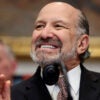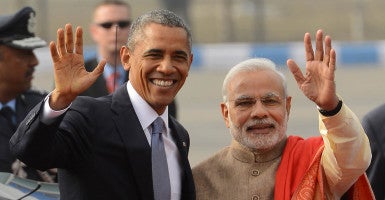Since taking office over 16 months ago, Indian Prime Minister Modi has energized India’s foreign policy and raised the country’s global profile. At the core of Modi’s international outreach has been a concerted effort to improve U.S.-India relations, which foundered under the previous Manmohan Singh government.
Modi’s visit to Silicon Valley this weekend and summit meeting with President Barack Obama next Monday in New York provides an opportunity to showcase synergies between the two countries on a range of security and economic issues as well as draw a more distinctive picture of India’s role in the emerging security architecture of the Indo-Pacific.
Elevating Relations
Prime Minister Modi’s arrival in New York yesterday for the U.N. General Assembly follows on the heels of the first-ever U.S.-India Strategic and Commercial Dialogue (S&CD), which took place on Tuesday and was led by U.S. Vice President Joe Biden. Departing from the previous practice of separating the security and economic components of the bilateral dialogue, the S&CD raised the level of U.S.-India engagement and demonstrated the two sides’ mutual interest in advancing joint initiatives on a broad range of issues.
One major goal of the S&CD is to increase bilateral trade fivefold from its current level of over $100 billion to $500 billion in coming years. In order to achieve such an ambitious target, the two countries need to establish a better “trade architecture” to advance common goals and address areas of difference, according to U.S. Assistant Secretary of State for South and Central Asia Nisha Biswal.
For their part, U.S. lawmakers from the Senate Finance and House Ways and Means committees outlined concerns about Indo-U.S. trade in a letter to the Obama administration this week on inadequate intellectual property rights protection and numerous other trade barriers American exporters face in the Indian market.
It remains to be seen whether Modi will follow through on his promises of economic reform necessary to generate investment and unlock India’s economic potential. Bills to make it easier for private businesses to acquire land and to implement a nationwide goods and services tax have both stalled in the Indian parliament.
While foreign investors’ euphoria may have been tempered by Modi’s failure to push aggressively on the reform front, the economy has picked up on his watch, and economists are broadly optimistic about India’s near-term growth prospects, especially when compared with other emerging economies. A recent Pew Research survey that showed that Modi is wildly popular at home (87 percent of Indians said they had a favorable opinion of him) provides hope that he will capitalize on this popularity to push through reforms now that his first year in power is under his belt.
The U.S. agreement during the S&CD to work with India toward its eventual membership in the Asia Pacific Economic Cooperation (APEC) grouping is a welcome sign that the U.S. is confident that India will move in the right direction when it comes to addressing trade barriers and intellectual property concerns.
Modi is counting on wooing U.S. investors when he travels to Silicon Valley September 26-27 to meet with executives from Google, Apple, and Tesla Motors and holds a town hall meeting at Facebook headquarters hosted by CEO Mark Zuckerberg. Modi will also address the West Coast version of the Indian-American event hosted at Madison Square Garden last year, at which he spoke to a crowd of 20,000 about his vision for Indo-U.S. relations.
This time he will speak to around 17,000 Indian-Americans at the SAP arena in San Jose. Modi’s high-profile visit will showcase the role of Indians in building up the high-tech capital of the world (nearly one-fifth of technology start-ups in Silicon Valley are run by Indian-origin executives) as well as his “Digital India” campaign, which aims to increase Internet service for one billion Indians, giving them greater access to government and financial services.
Building on Security Cooperation
While economics may headline Modi’s visit, security cooperation will also be a major point of discussion. The Indian cabinet’s long overdue approval on Tuesday of a $2.5-billion deal to purchase 37 Apache and Chinook helicopters from Boeing will be touted as another indicator of the strengthening U.S.-India security partnership. The defense deal follows the renewal of the ten-year defense framework agreement earlier this year and the landmark Joint Strategic Vision for the Asia Pacific and Indian Ocean Region statement that was released during President Obama’s India visit in January. This statement directly referenced the South China Sea, sending a signal that the two countries would work together to harness Chinese territorial ambitions.
The BJP government has been more forward-leaning than the previous Congress-led government in working closely with the United States in the Asia-Pacific. The two nations have a mutual interest in securing sea lines of communication throughout the Indo-Pacific and in meeting potential challenges from China’s economic and military expansion. Modi also is acutely aware of the need for India to tend to its regional relationships as China increases its influence in South Asia.
India’s willingness to raise the U.S.-India-Japan trilateral engagement to the ministerial level and the three countries’ upcoming joint Malabar naval exercise in mid-October demonstrate Modi’s inclination to engage in multi-nation efforts, even at the risk of raising Chinese hackles. The fact that India turned down Australia’s offer to also participate in the Malabar naval exercise, however, shows there are limits to Indian interest in pushing the envelope with China.
Another key area of Indo-U.S. cooperation set to expand is cyber security. The Strategic and Commercial Dialogue resulted in the two sides agreeing to a Track 1.5 program to further discussions on Internet and cyber issues. A collaborative study by the U.S.-based Heritage Foundation and the India-based Observer Research Foundation released nearly a year ago highlighted the opportunity for cooperation in managing cyber threats.
With the third largest population of online users, India faces increasing vulnerabilities to cyber threats. India’s decision this summer to support a multi-stakeholder approach (that involves civil society and industry) regarding governance of the Internet opens the way for increased consultations between Washington and New Delhi on developing a framework for regulating the cyber domain.
Maintaining the Momentum
The United States must welcome Modi’s leadership and his initiative to engage with American businesses and entrepreneurs. While Modi may not have reached the euphoric expectations people had of him a year ago, he still deserves high marks for maintaining momentum in U.S.-India ties. As the United States roots for India to achieve a more robust economic, political, and military role on the global stage, Modi remains poised to take on the task.
Originally published in Foreign Policy.































